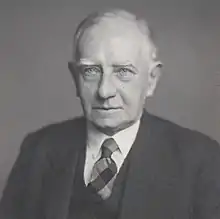Norman Kemp Smith
Norman Duncan Kemp Smith, FBA, FRSE (5 May 1872 – 3 September 1958) was a Scottish philosopher who was Professor of Psychology (1906–1914) and Philosophy (1914–1919) at Princeton University and was Professor of Logic and Metaphysics at the University of Edinburgh (1919–1945).[1]

He is noted for his 1929 English translation of Immanuel Kant's Critique of Pure Reason, which is often considered the standard version.[2][3]
Early life and education
He was born Norman Smith on 5 May 1872[4] in Dundee, Scotland,[5] the son of a cabinet-maker on the Nethergate.[6]
He was educated in Dundee and then studied mental philosophy at the University of St Andrews, graduating with an MA with first-class honours in 1893.[7] He received his doctorate (PhD) in 1902.
Career
He lectured in philosophy and psychology at Princeton University from 1906 to 1916, and at the University of Edinburgh from 1919 until his retirement in 1945.
He was elected a Fellow of the Royal Society of Edinburgh in 1921. His proposers were Ralph Allan Sampson, Thomas James Jehu, Charles Glover Barkla and Charles Sarolea.[8]
In 1932 he delivered the Adamson Lecture[9] of the Victoria University of Manchester.
In 1938 he moved to 14 Kilgraston Road in south Edinburgh, a house designed by Sir Robert Matthew.[10]
His translation of Immanuel Kant's Critique of Pure Reason is often used as the standard English version of the text. His commentaries on the Critique are also well regarded, as are his works on David Hume and other philosophers. He was president of the Aristotelian Society from 1947 to 1948. A portrait by the Edinburgh artist Adam Bruce Thomson is held by the University of Edinburgh's Fine Art Collection.[11]
Family
In 1910 he married Amy Kemp (d.1936), and thereafter became known as Norman Kemp Smith.[12]
Legacy
The Kemp Smith Room in the University of Edinburgh's Philosophy Department is named in his honour.[13]
Books and articles
- Studies in the Cartesian Philosophy (New York: Macmillan, 1902)
- "The Naturalism of Hume (I)" and "The Naturalism of Hume (II)", Mind, 14 (1905) Nos. 54 and 55: 149–73 and 335–47
- "Subjectivism and Realism in Modern Philosophy", The Philosophical Review, 17 (1908) No. 2: 138–48
- "How Far Is Agreement Possible in Philosophy?", The Journal of Philosophy, Psychology, and Scientific Methods, 9 (1912) No. 26: 701–11
- "Kant’s Relation to Hume and Leibniz", The Philosophical Review, 24 (1915) No. 3: 288–96
- A Commentary to Kant's 'Critique of Pure Reason' (London: Macmillan, 1918)
- Prolegomena to an Idealist Theory of Knowledge (London: Macmillan, 1924)
- The Philosophy of David Hume: A Critical Study of Its Origins and Central Doctrines. London: Macmillan. 1941 – via Internet Archive.
- New Studies in the Philosophy of Descartes (1951)
- The Credibility of Divine Existence. The Collected Papers of Norman Kemp Smith, edited by A. J. D. Porteous, R. D. MacLennan, and G. E. Davie (1967)[14]
References
- "Obituary: Prof. N. Kemp Smith – Kantian scholar". The Times. 6 September 1958. p. 11.
- Scruton, Roger (2001). Kant, A Very Short Introduction. Oxford University Press. p. 133. ISBN 978-0-19-280199-9.
- Immanuel Kant's Critique of Pure Reason. Translated by Norman Kemp Smith. London: Macmillan and Co. Limited. 1929 – via Internet Archive.
- "Norman Kemp Smith (1872-1958)". www.humesociety.org. Retrieved 28 May 2019.
- Porteous, A. J. D. (2015). The Credibility of Divine Existence: The Collected Papers of Norman Kemp Smith. Springer. p. 3. ISBN 9781349816552. Retrieved 4 July 2017.
- Dundee Post Office Directory 1871
- "Professor Norman Kemp Smith. A translator of Descartes". The Glasgow Herald. 4 September 1958. p. 9. Retrieved 15 May 2017.
- Biographical Index of Former Fellows of the Royal Society of Edinburgh 1783–2002 (PDF). The Royal Society of Edinburgh. July 2006. ISBN 0-902-198-84-X. Archived from the original (PDF) on 4 March 2016. Retrieved 27 July 2018.
- "John Locke (1632-1704): the Adamson lecture for 1932, by Norman Kemp Smith". Catalogue, National Library of Australia.
- "Norman Kemp Smith". The University of Edinburgh. Retrieved 28 May 2019.
- "Portrait of Norman Kemp Smith". Retrieved 20 February 2015.
- Norman Kemp Smith | The University of Edinburgh, University of Edinburgh Philosophy Department web site. Retrieved 18 October 2023.
- Biographical Index of Former Fellows of the Royal Society of Edinburgh 1783–2002 (PDF). The Royal Society of Edinburgh. July 2006. ISBN 0-902-198-84-X. Archived from the original (PDF) on 4 March 2016. Retrieved 27 July 2018.
- Cowley, Fraser (1969). "Review of The Credibility of Divine Existence. The Collected Papers of Norman Kemp Smith. Edited by A. J. D. Porteous, R. D. MacLennan, and G. E. Davie". Dialogue. 8 (1): 126–128. doi:10.1017/S0012217300039846. ISSN 0012-2173.
Further reading
- Loeb, Louis E. (2009). What is Worth Preserving in the Kemp Smith Interpretation of Hume? British Journal for the History of Philosophy, 17(4), 769–797.
External links
- Profile of Kemp Smith on the Edinburgh University Philosophy Department site
- Works by Norman Kemp Smith at Project Gutenberg
- Works by or about Norman Kemp Smith at Internet Archive
- Online edition of Kemp Smith's translation of the Critique of Pure Reason
- Norman Kemp Smith (1872-1958) hosted by The Hume Society, selected from Geoffrey Gorham, Continuum Encyclopedia of British Philosophy (2006), ed. A.C. Grayling, Naomi Goulder, and Andrew Pyle
- Norman Kemp Smith (1872–1958) portrait painting by Adam Bruce Thomson - hosted at Art.uk
- Norman Kemp Smith bromide print by Walter Stoneman from 10 November 1947 - hosted by the National Portrait Gallery